- How to setup your software
- Sample MLA Paper – normal paper
- Sample MLA Paper – has cover page
- Sample APA Paper
- Sample Chicago Paper
- Sample CSE Paper
- APA Format Guidelines
- MLA Format Cover Page
The Modern Language Association (MLA) does not require you to create a cover page when you complete your research paper, but some instructors may require it.
If your instructor requires your paper to have a cover page, here is how to make it (very easy). This cover page should include: your school name, your research paper title, your name, your class, your professor name and your paper due date.

How to Format Your MLA Cover Page:
- This page is double spaced and the letters are centered.
- Font: Times New Roman
- Font size: 12
- The first letter of each word should be capitalized with the exception of very short words such as: the, and, of, or, a, an, in, to, for. Note: the first letter of the first word should be capitalized, regardless of what kind of word it is.
- Type the name of your university or college.
- Skip to about one-third of the page and type your research paper title, include a subtitle if you have.
- Skip several lines down and type your name, your course name and number, your instructor name and your paper’s due date.
Sample MLA Format Cover Page:

Sample MLA Format Cover Page
Alternate First Page:
If your instructor requires a cover page, you would omit the main heading on your first page. Here is an example of the first page if a cover page is used. You still need your last name and page number on the first page and every other page.

Sample MLA Format First Page with Cover Page

Sample MLA Paper:
Visit here for a sample paper with the cover page. The cover page can vary slightly. This paper also has the outline page for your sample.
If you find this website useful, please share with a friend:
How do I get the header on the second page on down? I tried editing it but then it takes the header away from all the pages.
In word select the header then go to: Header & Footer>Page Number>Format Page Numbers>Page Numbering>Start at page>Set to 0
How do I get the header on the second page on down? I tried editing it but then it takes the header away from all the pages. I am using windows. Also, the page numbers are not working for me either. Please help me.
How should I start the page after my cover page?
https://mlaformat.org/mla-format-heading/
Thank you so much Stephen !!! Helped a lot in my written assignments 🙂
Great site ! Thank you so much. Just returned to school to complete my bachelors and needed a little refreshing. Has all the information I needed !
Thanks so much for all of the great information! I have not used MLA before and was a little panic stricken. I have found all of my answers here. This is now saved to my favorites so I can use it regularly. Thanks again!
Should the lines on the cover page be double spaced?
Thanks so much for the picture of the cover page it has helped a lot. But, I was wondering do I still need to put my Title at the top of every page after the header?
Hello Lydia. You do not.
After your cover page, your next page’s heading should look like the “Alternate First Page” above.
After the “Alternate First Page” => your next pages should have “The Inner Pages” heading: https://mlaformat.org/mla-format-heading/
Sample paper: https://mlaformat.org/mla-format-sample-paper-with-cover-page-and-outline/
hey Lydia you don’t need to but if you want to you can
Thank you so so much. I love the simplicity of the website, very easy to understand. I finally have a cover page for my paper!!
I love this website!! It helped so many times with all my essays. I’m working on a college one and this was very useful. Thank you soo much. And thanks for the examples im a visual person I needed that 🙂
Hi Kaylin, I am glad you find this site useful. Take care!
By the way (sorry i forgot!) for the coverpage, would the text font be 12 times new roman???
You can set everything 12, Times New Roman. Or you can set the Title a little larger than 12, that should work too.
In the example above, I have the title larger than 12.
Here is an example with everything set at 12.
Thank you so much for your help on this useful website! I found it very organized and I’m very glad that I came across this particular article. Thanks!!!!!!!:)
I have a question regarding the cover page and the following pages. If I have a cover page as the example provided, do I still need the heading on the next page? And should the pages after that contain my last name on the top left as the header does on the on the previous pages? or do I not need the header at all if I have the cover page and just my name?
Excellence question, Stella! I have updated this article with information on the first page if a cover page is used. Please see “Alternate First Page” above.
You can omit the main heading but you still need your last name and page number on the first page and all subsequent pages. Take care!
Leave a Comment
Current ye ignore me @r *
Leave this field empty
Next post: MLA Format Heading
Previous post: MLA Format Websites
- The Format of the Research Paper
- MLA Format Headings
- MLA Citations
- MLA Format Works Cited
- MLA Format FAQs
- MLA Format Sample Paper
- MLA Sample Paper w/ Cover and Outline Pages
HOW TO SETUP YOUR SOFTWARE
- MLA Format using Google Docs
- MLA Format Microsoft Word 2016
- MLA Format using Pages on Mac
Copyright © 2011–2024 • MLA Format • All rights reserved. Currently, MLA is at its 8th edition. This website has no official relationship with the Modern Language Association and is not endorsed by the MLA.
BibGuru Blog
Be more productive in school
- Citation Styles
MLA title page: format and templates
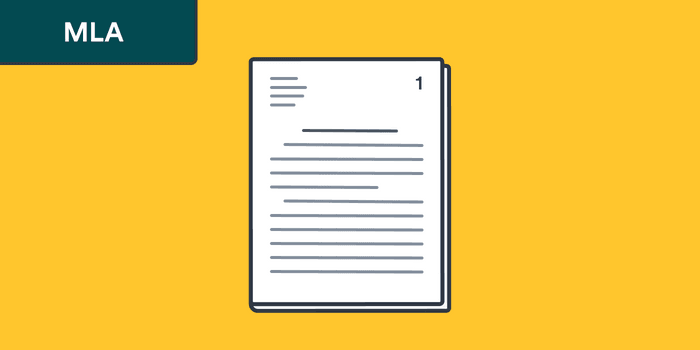
If you were instructed to include a cover or title page for your paper in MLA style 8th edition, these are the requirements you have to meet to have a proper MLA title page.
MLA cover page requirements
- 1 inch margins on all sides.
- Easily readable typeface (like Times New Roman), 11 or 12 points.
- Double-spacing throughout the paper.
- A header in the upper right-hand corner: give your last name, followed by a space with the page number. This should be included on all pages, one-half inch from the top.
- A header in the upper left-hand corner: author's name, instructor's name, the course, and the due date on separate lines and double-spaced.
- Right after, add the title on a new, double-spaced line, centered, in standard capitalization.
- Add a double space after the title and start with the first line of the text.
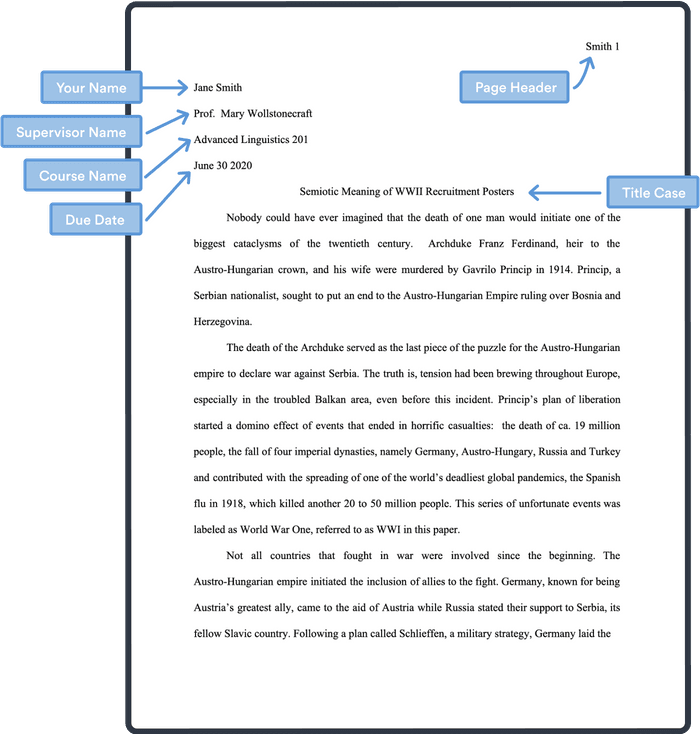
We created an MLA title page template (8th edition) for you to download:
Further reading
For more details not covered in this guide, take a look at the following sources:
📝 Sample papers in MLA Style
📑 MLA Style: Formatting a Research Paper
Frequently Asked Questions about MLA title page
Yes, according to MLA style, this is the only format to follow for any student or professional paper.
Yes, an MLA title page is very easy to format as it does not follow the classic format of a title page. You only have to add two headers in both upper corners of your paper's first page, the title, and right underneath you start writing. Piece of cake!
No. According to MLA style, the title should be written in the same font and format as the rest of the text. The title should only be placed centered.
Yes, a title page in MLA style should be numbered as page 1 of the paper.
If you learn better by watching than by reading, here is a YouTube tutorial that will help you create a title page in MLA style: MLA Essay Format (8th Edition) by The Nature of Writing.

Make your life easier with our productivity and writing resources.
For students and teachers.

MLA Style Guide, 8th & 9th Editions: Formatting Your MLA Paper
- Works Cited entries: What to Include
- Title of source
- Title of container
- Contributors
- Publication date
- Supplemental Elements
- Book with Personal Author(s)
- Book with Organization as Author
- Book with Editor(s)
- Parts of Books
- Government Publication
- Journal Article
- Magazine Article
- Multivolume Works
- Newspaper Article
- Other Formats
- Websites, Social Media, and Email
- About In-text Citations
- In-text Examples
- How to Paraphrase and Quote
- Citing Poetry
- Formatting Your MLA Paper
- Formatting Your Works Cited List
- MLA Annotated Bibliography
- MLA 9th Edition Quick Guide
- Submit Your Paper for MLA Style Review
MLA recommends using 12-point Times New Roman font or another readable typeface (e.g. serif ).
Line Spacing & Margins
Use double-spacing throughout the entire paper.
Leave 1 inch margins on the top, bottom, and each side.
Indent the first line of each paragraph half an inch from the left margin.
Quotes longer than 4 lines should be written as a block of text a half an inch from the left margin.
Heading and Title
An MLA research paper does not need a title page, but your instructor may require one. If no instructions are given, follow the MLA guidelines below:
Type the following one inch from the top of the first page, flush with the left margin (double spacing throughout).
Your Instructor's Name
Course Number or Name
Center the title on the next line. Follow the rules for capitalization. Do not italicize, underline, or bold the title. An exception is when your title includes a title. Example: The Attitude toward Violence in A Clockwork Orange
Indent the next line and begin typing your text.
Include your last name and page numbers in the upper right-hand corner of every page. The page numbers will be one-half inch from the top and flush with the right margin. If your instructor prefers no page number on the first page, begin numbering from 2 on the second page.
Sample Papers from MLA
There are sample papers available in the MLA Style Center. Check them out to see the correct formatting.
Styling Headings and Subheadings
According to the MLA Style Center website, writers should avoid using headings in shorter papers. If you are writing a longer research paper, you may want to include headings and subheadings to help organize the sections of your paper. Advice from the MLA Style Center :
"Levels
The paper or chapter title is the first level of heading, and it must be the most prominent.
Headings should be styled in descending order of prominence. After the first level, the other headings are subheadings—that is, they are subordinate. Font styling and size are used to signal prominence. In general, a boldface, larger font indicates prominence; a smaller font, italics, and lack of bold can be used to signal subordination. For readability, don’t go overboard: avoid using all capital letters for headings (in some cases, small capitals may be acceptable):
Heading Level 1
Heading Level 2
Heading Level 3
Note that word-processing software often has built-in heading styles.
Consistency
Consistency in the styling of headings and subheadings is key to signaling to readers the structure of a research project. That is, each level 1 heading should appear in the same style and size, as should each level 2 heading, and so on. Generally, avoid numbers and letters to designate heads unless you are working in a discipline where doing so is conventional. Note that a heading labeled “1” requires a subsequent heading labeled “2,” and a heading labeled “a” requires a subsequent heading labeled “b.”
In a project that is not professionally designed and published, headings should be flush with the left margin, to avoid confusion with block quotations. (The exception is the paper or chapter title, which is centered in MLA style.)
For readability, it is helpful to include a line space above and below a heading, as shown in this post.
No internal heading level should have only one instance. For example, if you have one level 1 heading, you need to have a second level 1 heading. (The exceptions are the paper or chapter title and the headings for notes and the list of works cited.) You should also generally have text under each heading.
Capitalization
Capitalize headings like the titles of works, as explained in section 1.2 of the MLA Handbook.
The shorter, the better."
Modern Language Association. "How Do I Style Headings and Subheadings in a Research Paper?" MLA Style Center., 13 December 2018, style.mla.org/styling-headings-and-subheadings .
MLA Style Paper Template
- MLA 9th Edition Paper Template This template was created and saved as a Word template for Microsoft Word 2016. The process for saving and using the template is the same for the instructions given above for 2013.
You can save a personal template in Microsoft Word (IRSC students, download Office for free, see a librarian if you need help). Above is a template you can use every time you need to set-up a research paper using MLA style format. Simply open the template and type your own information every time you need to write an MLA style paper. Microsoft Word will allow you to save personal templates. Once you have the template opened in Word
Click "Save as"
Give the file a name
Under "Save as type", select Word Template

Then when you open Word, you will be able to choose a template rather than a blank document. You might have to select Personal to find your template.

Sample MLA Paper

How to Use the MLA Style Template
Formatting Group Project Papers
For a research paper written collaboratively by several students, such as for a group project, create a title page instead of listing all authors in the header on page 1 of the essay. On the title page, list each student's full name, placing one name on each double-spaced line. After the final student name, enter the professor's name. After the professor's name, give the course name. The last line of the heading will be the date in 5 August 2021 format. Press Enter a few times to move down the page then give the paper title, centered.

- << Previous: Citing Poetry
- Next: Formatting Your Works Cited List >>
- Last Updated: Jan 23, 2024 11:37 AM
- URL: https://irsc.libguides.com/mla
Home / Guides / Writing Guides / Parts of a Paper / How to Write an Essay Cover Page
How to Write an Essay Cover Page
What you include in your cover page depends slightly on which citation style you are using, but the rules are generally the same.
Guide Overview
- APA cover pages
- MLA cover pages
For APA cover pages:
Include the title of the paper, running head, the author’s name, institutional affiliation, and an author’s note.
Here is an example of a cover page in APA:

For MLA cover pages:
Cover pages are not as frequently used in MLA format, as the inclusion of headers is preferred.
A header looks like this:

Cover pages can include the name of your school, your paper title, your name, your course name, your teacher or professor’s name, and the due date of the paper. If you are unsure of what to include, check with your instructor.
Here is an example of a cover page in MLA format:

For more help making cover or title pages, visit our title page generator here.
EasyBib Writing Resources
Writing a paper.
- Academic Essay
- Argumentative Essay
- College Admissions Essay
- Expository Essay
- Persuasive Essay
- Research Paper
- Thesis Statement
- Writing a Conclusion
- Writing an Introduction
- Writing an Outline
- Writing a Summary
EasyBib Plus Features
- Citation Generator
- Essay Checker
- Expert Check Proofreader
- Grammar Checker
- Paraphrasing Tools
Plagiarism Checker
- Spell Checker
How useful was this post?
Click on a star to rate it!
We are sorry that this post was not useful for you!
Let us improve this post!
Tell us how we can improve this post?
Grammar and Plagiarism Checkers
Grammar Basics
Plagiarism Basics
Writing Basics
Upload a paper to check for plagiarism against billions of sources and get advanced writing suggestions for clarity and style.
Get Started
Purdue Online Writing Lab Purdue OWL® College of Liberal Arts
MLA Formatting and Style Guide

Welcome to the Purdue OWL
This page is brought to you by the OWL at Purdue University. When printing this page, you must include the entire legal notice.
Copyright ©1995-2018 by The Writing Lab & The OWL at Purdue and Purdue University. All rights reserved. This material may not be published, reproduced, broadcast, rewritten, or redistributed without permission. Use of this site constitutes acceptance of our terms and conditions of fair use.
The following overview should help you better understand how to cite sources using MLA 9 th edition, including how to format the Works Cited page and in-text citations.
Please use the example at the bottom of this page to cite the Purdue OWL in MLA. See also our MLA vidcast series on the Purdue OWL YouTube Channel .

Creating a Works Cited list using the ninth edition
MLA is a style of documentation that may be applied to many different types of writing. Since texts have become increasingly digital, and the same document may often be found in several different sources, following a set of rigid rules no longer suffices.
Thus, the current system is based on a few guiding principles, rather than an extensive list of specific rules. While the handbook still describes how to cite sources, it is organized according to the process of documentation, rather than by the sources themselves. This gives writers a flexible method that is near-universally applicable.
Once you are familiar with the method, you can use it to document any type of source, for any type of paper, in any field.
Here is an overview of the process:
When deciding how to cite your source, start by consulting the list of core elements. These are the general pieces of information that MLA suggests including in each Works Cited entry. In your citation, the elements should be listed in the following order:
- Title of source.
- Title of container,
- Other contributors,
- Publication date,
Each element should be followed by the corresponding punctuation mark shown above. Earlier editions of the handbook included the place of publication and required different punctuation (such as journal editions in parentheses and colons after issue numbers) depending on the type of source. In the current version, punctuation is simpler (only commas and periods separate the elements), and information about the source is kept to the basics.
Begin the entry with the author’s last name, followed by a comma and the rest of the name, as presented in the work. End this element with a period.
Bhabha, Homi K. The Location of Culture. Routledge, 1994.
Title of source
The title of the source should follow the author’s name. Depending upon the type of source, it should be listed in italics or quotation marks.
A book should be in italics:
Henley, Patricia. The Hummingbird House . MacMurray, 1999.
An individual webpage should be in quotation marks. The name of the parent website, which MLA treats as a "container," should follow in italics:
Lundman, Susan. "How to Make Vegetarian Chili." eHow, www.ehow.com/how_10727_make-vegetarian-chili.html.*
A periodical (journal, magazine, newspaper) article should be in quotation marks:
Bagchi, Alaknanda. "Conflicting Nationalisms: The Voice of the Subaltern in Mahasweta Devi's Bashai Tudu." Tulsa Studies in Women's Literature , vol. 15, no. 1, 1996, pp. 41-50.
A song or piece of music on an album should be in quotation marks. The name of the album should then follow in italics:
Beyoncé. "Pray You Catch Me." Lemonade, Parkwood Entertainment, 2016, www.beyonce.com/album/lemonade-visual-album/.
*The MLA handbook recommends including URLs when citing online sources. For more information, see the “Optional Elements” section below.
Title of container
The eighth edition of the MLA handbook introduced what are referred to as "containers," which are the larger wholes in which the source is located. For example, if you want to cite a poem that is listed in a collection of poems, the individual poem is the source, while the larger collection is the container. The title of the container is usually italicized and followed by a comma, since the information that follows next describes the container.
Kincaid, Jamaica. "Girl." The Vintage Book of Contemporary American Short Stories, edited by Tobias Wolff, Vintage, 1994, pp. 306-07.
The container may also be a television series, which is made up of episodes.
“94 Meetings.” Parks and Recreation, created by Greg Daniels and Michael Schur, performance by Amy Poehler, season 2, episode 21, Deedle-Dee Productions and Universal Media Studios, 2010.
The container may also be a website, which contains articles, postings, and other works.
Wise, DeWanda. “Why TV Shows Make Me Feel Less Alone.” NAMI, 31 May 2019, www.nami.org/Blogs/NAMI-Blog/May-2019/How-TV-Shows-Make-Me-Feel-Less-Alone . Accessed 3 June 2019.
In some cases, a container might be within a larger container. You might have read a book of short stories on Google Books , or watched a television series on Netflix . You might have found the electronic version of a journal on JSTOR. It is important to cite these containers within containers so that your readers can find the exact source that you used.
“94 Meetings.” Parks and Recreation , season 2, episode 21, NBC , 29 Apr. 2010. Netflix, www.netflix.com/watch/70152031?trackId=200256157&tctx=0%2C20%2C0974d361-27cd-44de-9c2a-2d9d868b9f64-12120962.
Langhamer, Claire. “Love and Courtship in Mid-Twentieth-Century England.” Historical Journal , vol. 50, no. 1, 2007, pp. 173-96. ProQuest, doi:10.1017/S0018246X06005966. Accessed 27 May 2009.
Other contributors
In addition to the author, there may be other contributors to the source who should be credited, such as editors, illustrators, translators, etc. If their contributions are relevant to your research, or necessary to identify the source, include their names in your documentation.
Foucault, Michel. Madness and Civilization: A History of Insanity in the Age of Reason. Translated by Richard Howard , Vintage-Random House, 1988.
Woolf, Virginia. Jacob’s Room . Annotated and with an introduction by Vara Neverow, Harcourt, Inc., 2008.
If a source is listed as an edition or version of a work, include it in your citation.
The Bible . Authorized King James Version, Oxford UP, 1998.
Crowley, Sharon, and Debra Hawhee. Ancient Rhetorics for Contemporary Students. 3rd ed., Pearson, 2004.
If a source is part of a numbered sequence, such as a multi-volume book or journal with both volume and issue numbers, those numbers must be listed in your citation.
Dolby, Nadine. “Research in Youth Culture and Policy: Current Conditions and Future Directions.” Social Work and Society: The International Online-Only Journal, vol. 6, no. 2, 2008, www.socwork.net/sws/article/view/60/362. Accessed 20 May 2009.
Quintilian. Institutio Oratoria. Translated by H. E. Butler, vol. 2, Loeb-Harvard UP, 1980.
The publisher produces or distributes the source to the public. If there is more than one publisher, and they are all are relevant to your research, list them in your citation, separated by a forward slash (/).
Klee, Paul. Twittering Machine. 1922. Museum of Modern Art, New York. The Artchive, www.artchive.com/artchive/K/klee/twittering_machine.jpg.html. Accessed May 2006.
Women's Health: Problems of the Digestive System . American College of Obstetricians and Gynecologists, 2006.
Daniels, Greg and Michael Schur, creators. Parks and Recreation . Deedle-Dee Productions and Universal Media Studios, 2015.
Note : The publisher’s name need not be included in the following sources: periodicals, works published by their author or editor, websites whose titles are the same name as their publisher, websites that make works available but do not actually publish them (such as YouTube , WordPress , or JSTOR ).
Publication date
The same source may have been published on more than one date, such as an online version of an original source. For example, a television series might have aired on a broadcast network on one date, but released on Netflix on a different date. When the source has more than one date, it is sufficient to use the date that is most relevant to your writing. If you’re unsure about which date to use, go with the date of the source’s original publication.
In the following example, Mutant Enemy is the primary production company, and “Hush” was released in 1999. Below is a general citation for this television episode:
“Hush.” Buffy the Vampire Slayer , created by Joss Whedon, performance by Sarah Michelle Gellar, season 4, Mutant Enemy, 1999 .
However, if you are discussing, for example, the historical context in which the episode originally aired, you should cite the full date. Because you are specifying the date of airing, you would then use WB Television Network (rather than Mutant Enemy), because it was the network (rather than the production company) that aired the episode on the date you’re citing.
“Hush.” Buffy the Vampire Slayer, created by Joss Whedon, performance by Sarah Michelle Gellar, season 4, episode 10, WB Television Network, 14 Dec. 1999 .
You should be as specific as possible in identifying a work’s location.
An essay in a book or an article in a journal should include page numbers.
Adiche, Chimamanda Ngozi. “On Monday of Last Week.” The Thing around Your Neck, Alfred A. Knopf, 2009, pp. 74-94 .
The location of an online work should include a URL. Remove any "http://" or "https://" tag from the beginning of the URL.
Wheelis, Mark. "Investigating Disease Outbreaks Under a Protocol to the Biological and Toxin Weapons Convention." Emerging Infectious Diseases , vol. 6, no. 6, 2000, pp. 595-600, wwwnc.cdc.gov/eid/article/6/6/00-0607_article. Accessed 8 Feb. 2009.
When citing a physical object that you experienced firsthand, identify the place of location.
Matisse, Henri. The Swimming Pool. 1952, Museum of Modern Art, New York .
Optional elements
The ninth edition is designed to be as streamlined as possible. The author should include any information that helps readers easily identify the source, without including unnecessary information that may be distracting. The following is a list of optional elements that can be included in a documented source at the writer’s discretion.
Date of original publication:
If a source has been published on more than one date, the writer may want to include both dates if it will provide the reader with necessary or helpful information.
Erdrich, Louise. Love Medicine. 1984. Perennial-Harper, 1993.
City of publication:
The seventh edition handbook required the city in which a publisher is located, but the eighth edition states that this is only necessary in particular instances, such as in a work published before 1900. Since pre-1900 works were usually associated with the city in which they were published, your documentation may substitute the city name for the publisher’s name.
Thoreau, Henry David. Excursions . Boston, 1863.
Date of access:
When you cite an online source, the MLA Handbook recommends including a date of access on which you accessed the material, since an online work may change or move at any time.
Bernstein, Mark. "10 Tips on Writing the Living Web." A List Apart: For People Who Make Websites, 16 Aug. 2002, alistapart.com/article/writeliving. Accessed 4 May 2009.
As mentioned above, while the MLA handbook recommends including URLs when you cite online sources, you should always check with your instructor or editor and include URLs at their discretion.
A DOI, or digital object identifier, is a series of digits and letters that leads to the location of an online source. Articles in journals are often assigned DOIs to ensure that the source is locatable, even if the URL changes. If your source is listed with a DOI, use that instead of a URL.
Alonso, Alvaro, and Julio A. Camargo. "Toxicity of Nitrite to Three Species of Freshwater Invertebrates." Environmental Toxicology , vol. 21, no. 1, 3 Feb. 2006, pp. 90-94. Wiley Online Library, doi: 10.1002/tox.20155.
Creating in-text citations using the previous (eighth) edition
Although the MLA handbook is currently in its ninth edition, some information about citing in the text using the older (eighth) edition is being retained. The in-text citation is a brief reference within your text that indicates the source you consulted. It should properly attribute any ideas, paraphrases, or direct quotations to your source, and should direct readers to the entry in the Works Cited list. For the most part, an in-text citation is the author’s name and the page number (or just the page number, if the author is named in the sentence) in parentheses :
When creating in-text citations for media that has a runtime, such as a movie or podcast, include the range of hours, minutes and seconds you plan to reference. For example: (00:02:15-00:02:35).
Again, your goal is to attribute your source and provide a reference without interrupting your text. Your readers should be able to follow the flow of your argument without becoming distracted by extra information.
How to Cite the Purdue OWL in MLA
Entire Website
The Purdue OWL . Purdue U Writing Lab, 2019.
Individual Resources
Contributors' names. "Title of Resource." The Purdue OWL , Purdue U Writing Lab, Last edited date.
The new OWL no longer lists most pages' authors or publication dates. Thus, in most cases, citations will begin with the title of the resource, rather than the developer's name.
"MLA Formatting and Style Guide." The Purdue OWL, Purdue U Writing Lab. Accessed 18 Jun. 2018.
- How To Setup Your Software
- Motivational Stories
- Funny Jokes
- Memory Techniques
MLA Format Sample Paper, with Cover Page and Outline
Here is a sample paper in MLA format that has both the cover page and the outline pages . This paper has 10 pages so if you are under a slow Internet connection, please wait a few seconds for all of the pages to load. This paper is current with the latest MLA manual.

MLA Format Sample Paper, Title Page

MLA Format Sample Paper, Outline Page 1

MLA Format Sample Paper, Outline Page 2
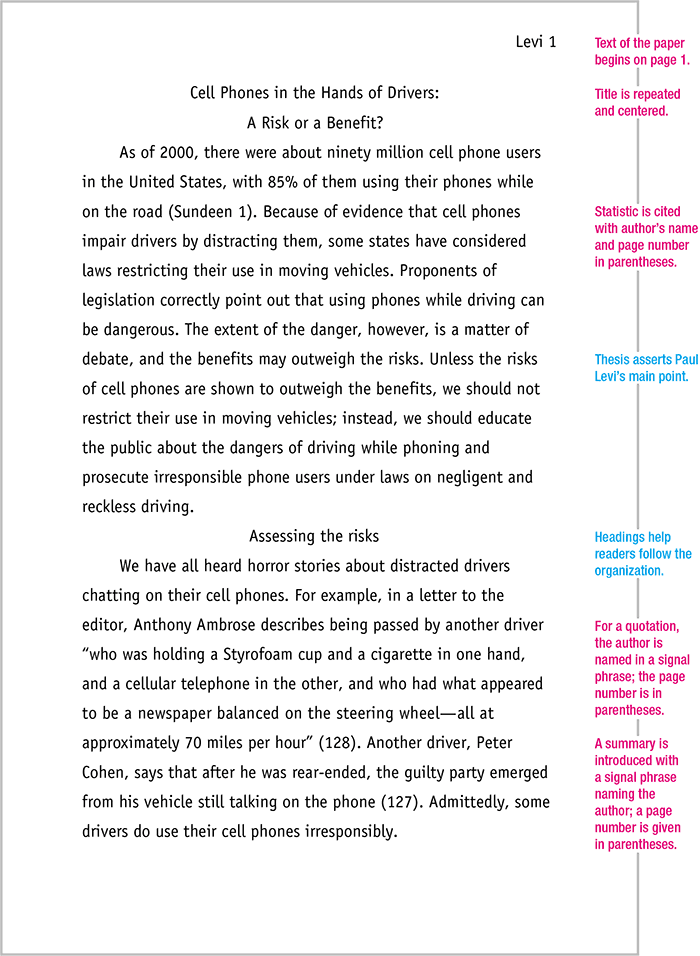
MLA Format Sample Paper, Page 1
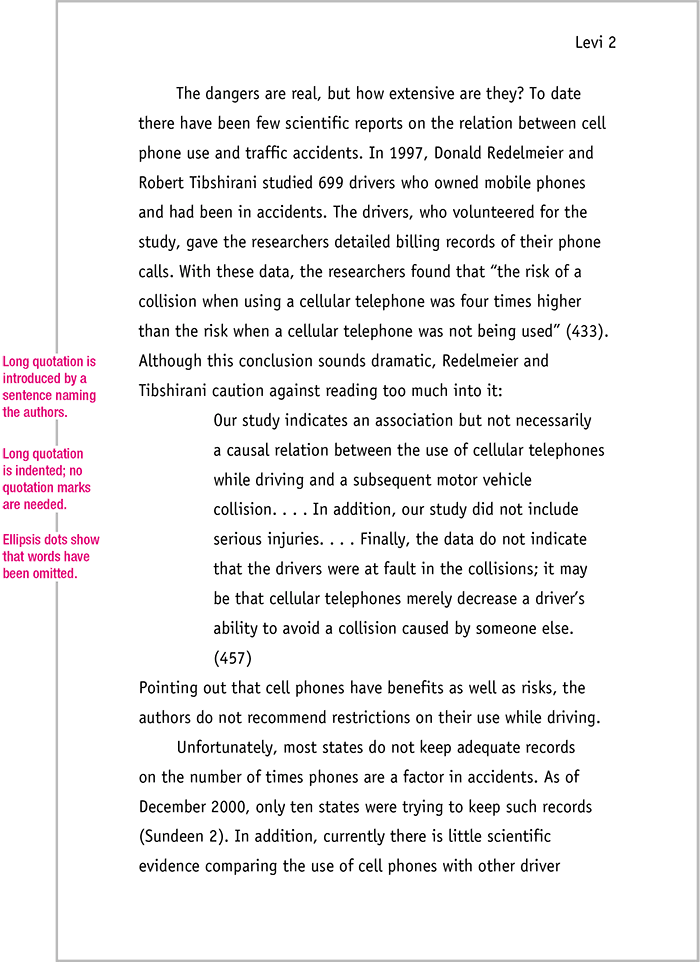
MLA Format Sample Paper, Page 2
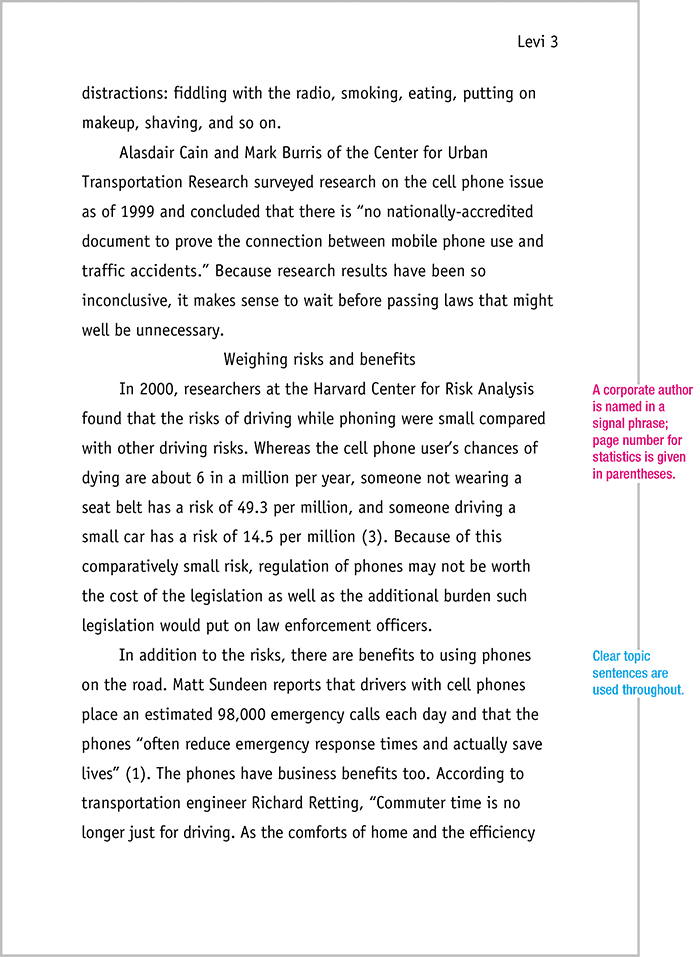
MLA Format Sample Paper, Page 3
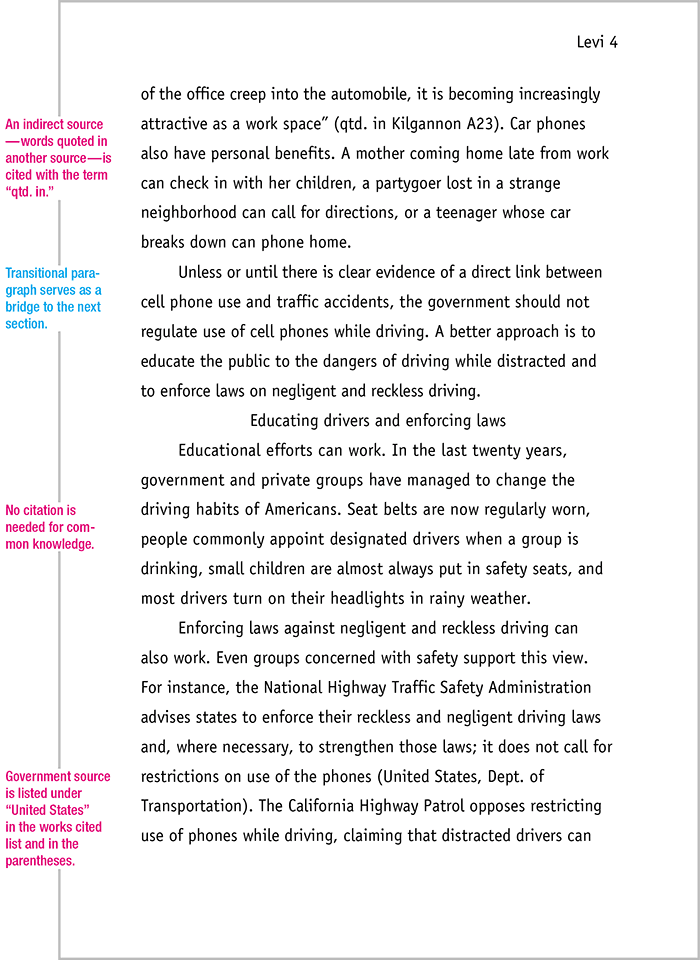
MLA Format Sample Paper, Page 4
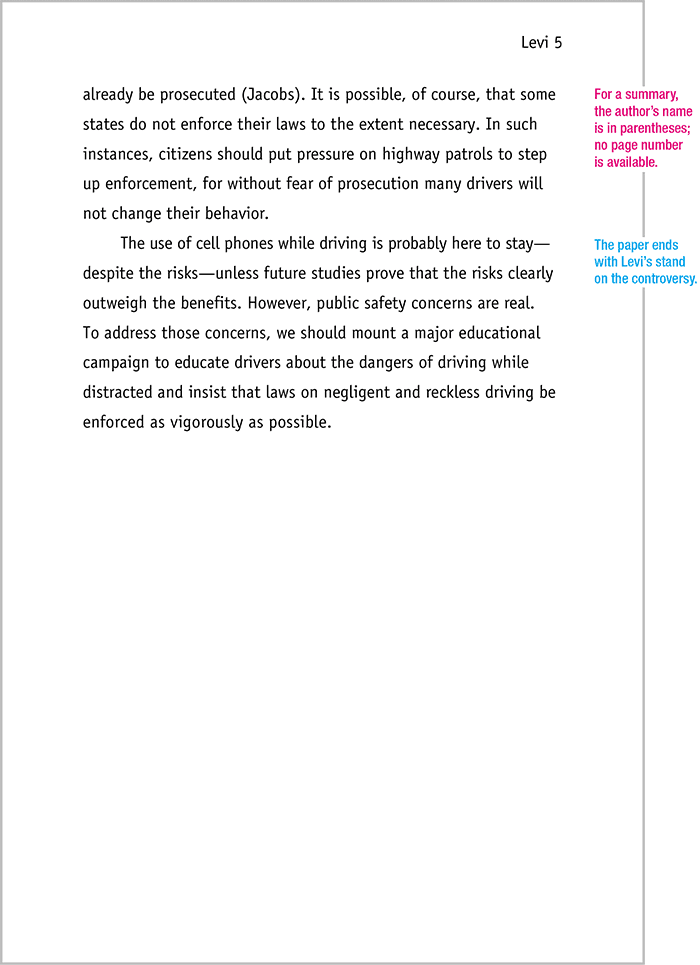
MLA Format Sample Paper, Page 5

MLA Format Sample Paper, Works Cited

MLA Format Sample Paper, End of Sample Paper.
– Diana Hacker (Boston: Bedford/St. Martin’s, 2006).
Very helpful information.
Intructions are clear in the begining.
Thank you, This will certainly help with assignments
I don’t care
Concise and easy to understand example. Thank you for your effort.
I am an older student returning to college and this helped me so much.
I didn’t have a clue what this format was, now I do. Thank you for your help.
Thank you for this resource; I am teaching MLA formatting to high school students and this will help with the “Why do we have to do it this way?!” questions. I just update them on the 8th edition changes.
The only way to achieve happiness is to cherish what you have and forget what you don’t have
thank you so much for your reference!
Thank you! I found your outline super helpful!
Awesome! Thank you so much. This information was so helpful. 🙂
Thank you so much. This is such a big help. God bless!
very helpful
Very helpful
thank yu its amazing helped me with assignments
Leave a Comment
Current ye ignore me @r *
Leave this field empty
Next post: APA Format Title Page
Previous post: MLA Format Sample Paper
- How to Format the Research Paper
- MLA Format Cover Page
- MLA Format Headings
- MLA Citations
- MLA Format Works Cited
- MLA Format Sample Paper
- MLA Sample Paper w/ Cover & Outline Pages
- MLA Format FAQs
- General Format of the APA Paper
- APA Format Title Page
- APA Format Abstract Page
- APA Headings
- APA Format Citations
- APA Reference Page
- APA Sample Paper
AcademicTips.org 1999–2024 • MLA Format • Privacy • Back to top ↑

Essay Cover Page - MLA, Chicago, Harvard, and APA Format Cover Sheet
Picture this, you have completed your daily duties and now settling in to complete an essay. What is the worst that would happen? Well, the majority of high school, college, university, and graduate students undervalue the need to format an essay cover page properly. In return, most of them end up with either great essays with a poorly done cover page or a poorly done essay with a poorly formatted cover page.
I don’t know which of the above categories, but mine was worse. It is a great mistake to care less about the proper formatting of a title page for any essay. Sometimes the content in the entire class can be great, and the cover page becomes what separates a good grade from a poor grade. You do not have to leave anything to chance when working to maintain a good GPA, do you?
Why master how to make an essay Cover Sheet?
Your title page informs the reader or the professor what to anticipate in your essay. Sometimes, if they are in a hurry, a catchy topic can entice them to read your essay from introduction to conclusion.
The cover page has your name, title of the essay, institution, instructor, and date. A well-formatted title page is enough a getaway to a strict professor’s marks or grade fountain.
And when you are almost giving up on your cover page, we give you a reason to smile. In this article, we will teach you how to make a cover page for an essay, MLA cover page format, Chicago cover page format, APA cover page format, and Harvard cover page format, with examples.
Why should you learn How to Make a Cover Page for an essay?
Sometimes professors and instructors assume the basic things like formatting a college essay. In the end, students end up losing marks over flimsy mistakes. A common question students ask is “how do you make a cover page for an essay?” or “what is to be included on a title page?”
If you have had these questions or related ones, you are in the right place at the right time. We will take you through cover page essay essentials. But before then, why do we have an essay cover page. Or simply, what is an essay cover page?
An essay cover page is the opening page, sometimes called the title page, and offers a comprehensive description of the essay title, identifies the student, and sometimes bears the date and the instructors’ names.
You will notice that the cover pages for essays differ depending on the specific format you are using. For instance, when creating the MLA essay cover page format, you should only do so if the essay prompt requires you to. If not asked for one, there is never any need to include one. The same applies to Harvard, Chicago, and APA cover page formats.
MLA Essay Cover Page Format with Template/Example
Also known as the Modern Language Association, MLA is a unique essay writing and citation format. It is important to mention that most MLA essays do not require an essay cover page. Nevertheless, some instructors insist on you having a cover page for your MLA paper.
When requested to have an opening or cover page for MLA papers, these are some of the details to include:
- Author’s Name
- Instructor’s Name
- The Due Date
Here is a sample MLA cover page template

Note that the format for MLA research paper cover page is slightly different. It will contain:
- Name of university
- Title of the Research Paper
- The subtitle of the research paper
- Your Name (Author’s Name)
- Course Name and Number
- Instructor/Professor’s Name
Below is a sample MLA research paper cover sheet
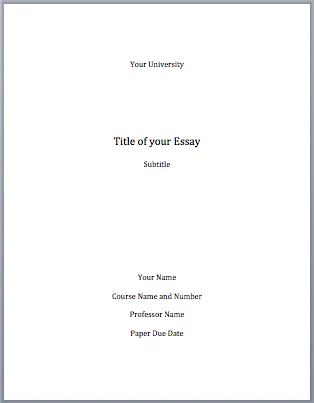
Some professors or instructors will advise you to use the research paper MLA format title page for your essay.
How do you format an MLA Cover Page?
Formatting an MLA title page is easy!
- It should be double-spaced.
- The preferable font is Times New Roman size 12 or a legible font.
- All the letters must be in Title Case.
- It should have 1-inch margins throughout the paper.
- Ensure that the title page is double spaced.
- Remove any spaces between paragraphs from your Microsoft Word settings page.
See the details in the sample MLA format cover page provided above. Notice the difference between the two and always read the instructor’s essay prompt before deciding on which one to settle for.
APA Cover Page Format with Example/Template
Students have been asking this for a while, and we felt like addressing it would save many of you out there. “How do I make an APA cover sheet?” Well, just like MLA, an APA essay cover page is easy to make.
To begin with, the APA style title page should include:
- Running head (Left aligned in the header section).
- Page Number (Right aligned).
- Title and subtitle of the essay/paper (centered)
- Name of the author (centered).
- Institutional Affiliation (centered).
- Author’s Note (for long research papers, thesis, and dissertations).
An important note, in APA the title should not exceed 50 characters and should be in capital letters. Times New Roman font size 12 is always preferred as well.
For more details, see the example APA title page provided below.

Note that there are changes to APA 6. In APA 7, there is no "Running head" instead, you will only need a page number situated to the top left of the paper. Here is a sample APA 7 Cover page.
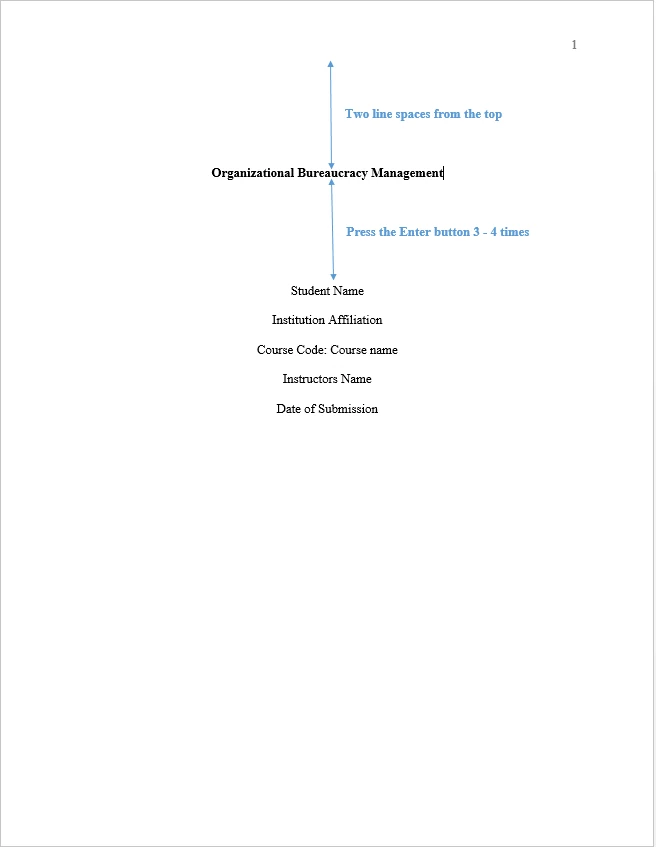
Chicago Cover Page Format with Example/Template
Even though less common in academic essay writing, understanding the Chicago essay title page is necessary. It can save you some trouble when writing a Chicago style paper, which is the case with most literature and humanities subjects such as history. Thus, after reading this, you should understand how to format a Chicago essay title cover page correctly.
Here are tips when making Chicago format opening page:
- Chicago title page has no page number or running head in the header section.
- Using Times New Roman or any legible font of size 12 is preferred.
- All the text on the cover page is centered.
- The cover page is double spaced with no spaces between paragraphs
You see, a Chicago style paper opening page is relatively simple to make. A caution, though, when making any type of cover page, your professor’s guidelines are your rule book. Therefore, everything you need to format an essay cover page is always in the prompt.
Chicago style papers are the easiest to handle. However, despite the ease of inserting a title page, it remains a challenge to most students. Sometimes, seeking professional help can be the only option. Our experts can help you craft your Chicago format essays and research papers, talk to us!
Here is a Chicago style format essay cover page.
Harvard Cover Page Format with Example/Template
Harvard formatting has a specific and well-organized cover page.
- The shortened version of the title of the paper comes in the header section (aligned to the right) and is preceded by the page number).
- The full title, written in all capital letters , appears halfway through the page.
- The author’s name (three lines from the title).
- Then four lines down you will have class name and code, name of the professor, City and State the university is located, and the due date.
Here is an example of the Harvard format Cover Sheet Page.
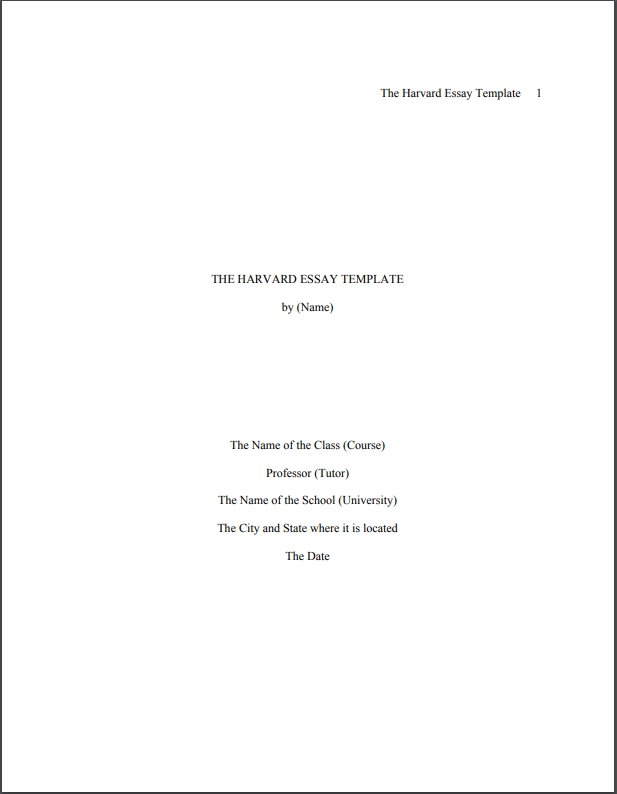
Bottom Line
A cover page for an essay is a critical aspect when undertaking your academic writing tasks. Even though it might seem boring and unnecessary, it can be the only aspect left to differentiate who passes a course and who fails.
When writing an APA, MLA, Harvard, or Chicago format paper, produce an essay cover page that fits each formatting and citation style. I don’t know about you, but I find it easier to do the cover page as the last part of the essay after writing and proofreading. Yet some in our team prefer setting the cover page for their essays first before they outline the essays . As a ritual, it is my last part to shake hands with the mighty Microsoft Word or Google Document applications.
Check out our article on indenting paragraphs and how to title an article when writing an essay.
Sometimes, you can ask the instructor or professor how to make a cover page for your essay. We believe no teacher will reprimand you. These are essential basics to keep with you as they will help you understand how to make a cover page for an essay. If you need help writing an essay, our professional writers can always come in handy. Until then, have a happy academic writing session!

Gradecrest is a professional writing service that provides original model papers. We offer personalized services along with research materials for assistance purposes only. All the materials from our website should be used with proper references. See our Terms of Use Page for proper details.

How to Make a Cover Page: Illustrative Formatting Examples
Table of contents
- 1.1 MLA Style Cover Page
- 1.2 APA Style Cover Page Format
- 1.3 Chicago Style Cover Page Format
- 1.4 ASA Style Cover Page
- 1.5 Harvard Cover Page Format
- 1.6 Bottom line
A perfect cover page is an essential part of an essay’s presentation. It can make a great first impression on your instructor and set the tone for your essay. First, to write a cover page, understand your assignment’s formatting requirements. This includes the required format for the cover page, which may vary depending on your instructor’s or institution’s guide.
Once you have this information, you can create a title page that looks professional. It should include the title of your essay , your name, the course title, and other pertinent details. In this guide, we’ll walk you through how to make a cover page for an essay. This article will show the following:
- We’ll describe how a good cover page should look.
- In the article, we offer you examples of different formats of a cover page, including MLA, APA, and more.
- You’ll know the measurements you require to position some cover page aspects.
What Does a Paper Cover Page Look Like?
Creating a cover page for an essay in grade school was simple – add your name and date, and it’s done. However, structuring an essay and following grammar rules in university involves multiple steps that may be unfamiliar to you. But knowing how to format an essay can make the process easier. However, it can be overwhelming to determine the appropriate structure and ensure that your essay adheres to grammatical rules.
A well-designed cover page is crucial for an essay’s presentation; many students wonder how to make one. Therefore, we have compiled a guide on creating a title page for the most commonly used citation formats you may come across.
A cover page is a separate page at the beginning of your academic essay. It contains the title and author’s name and may also feature details like page number, course name, instructor name, and more. Remember that it’s essential to format your page consistently with the rest of your essay.
Use these tips when writing your cover page:
- Keep every margin at 1 inch;
- Select a font that’s easy to read. We’d recommend Times New Roman and Arial for this;
- Always keep the font size at 12;
- Use double-line spacing.
MLA Style Cover Page
The MLA cover page has a vague format for essay pages. Instead, formatting guidelines are based on your teacher’s preferences and standard MLA (Modern Language Association) text formatting. You can follow some best practices to create an MLA essay cover that looks professional. A typical sample MLA cover centers essay titles about one-third of the page’s length. You can also use italics or bold lettering to emphasize important words or phrases.
In our sample MLA format cover, including the necessary MLA heading in the top-left corner is crucial. Follow this guide for proper writing of the cover page template:
- Instructor’s name;
- Page number half an inch away from the top;
- Your name is an inch away from the top;
- The arrangement of the details is an inch away from the leftmost side of the sheet, while ensuring it’s double-spaced throughout;
- A half-inch indent in the first paragraph.
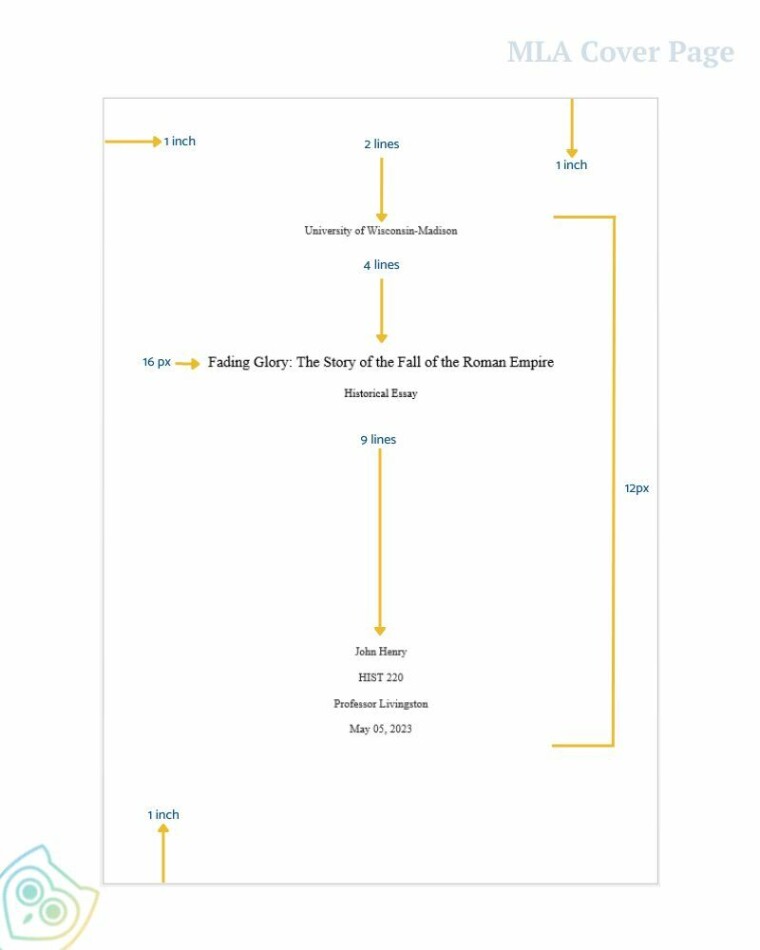
APA Style Cover Page Format
The APA citation format is widely used in the academic and business worlds but has some challenging aspects. For this reason, many busy students order cheap essays to avoid dealing with the nuances of APA essay cover. For your APA cover page, keep your essay’s title brief, under 12 words, and center it. Below the title, include your first, middle, initial, and last names without academic credentials like a PhD. On the following line, indicate your research location, usually your university. Below are the properties of the APA cover page format:
- The title of the paper, centered at the top of the page.
- Your name (student’s name), centered below the title.
- The institutional affiliation (college or university name), centered below your name.
- Course name and number.
- You professors’/instructor’s name.
- Optionally, you can include a running head aligned to the left margin (with the words “Running head:” followed by a shortened version of the title).
- Finally, include a page number in the top-right corner.
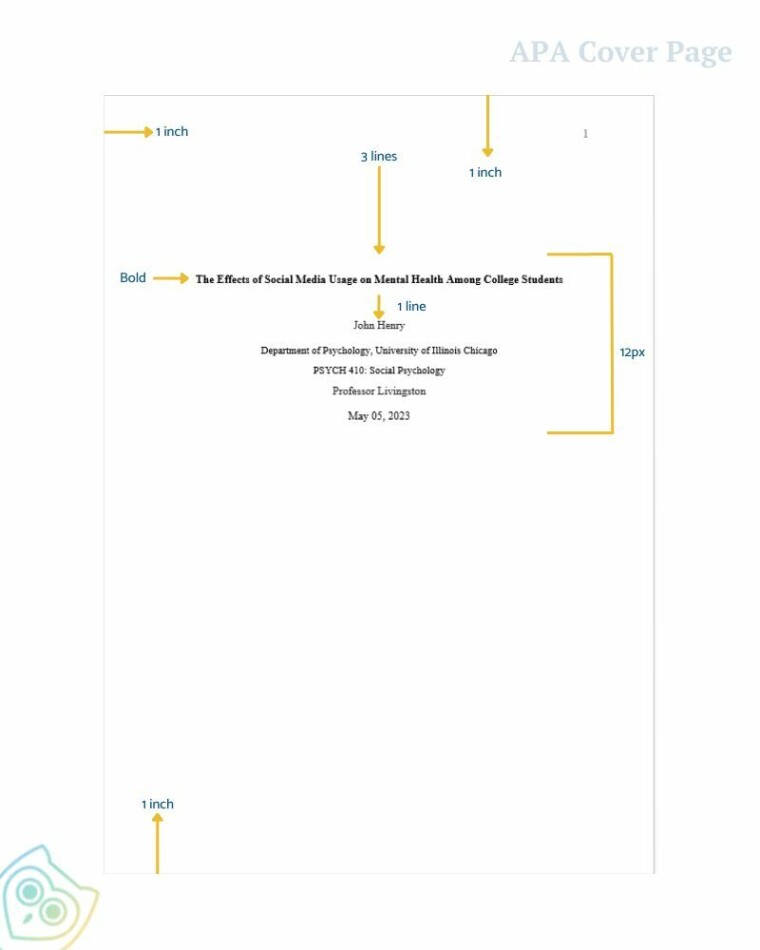
Chicago Style Cover Page Format
The Chicago page format, commonly called Chicago style paper, is a popular citation format used in the humanities department. The Chicago cover page format typically includes the following:
- The title of your essay centered on the page and in the title case (i.e., the first letter of each major word is capitalized);
- Your name is centered below the title;
- The course title is centered below your name;
- The instructor’s name is centered below the course title;
- The due date is centered below the instructor’s name.
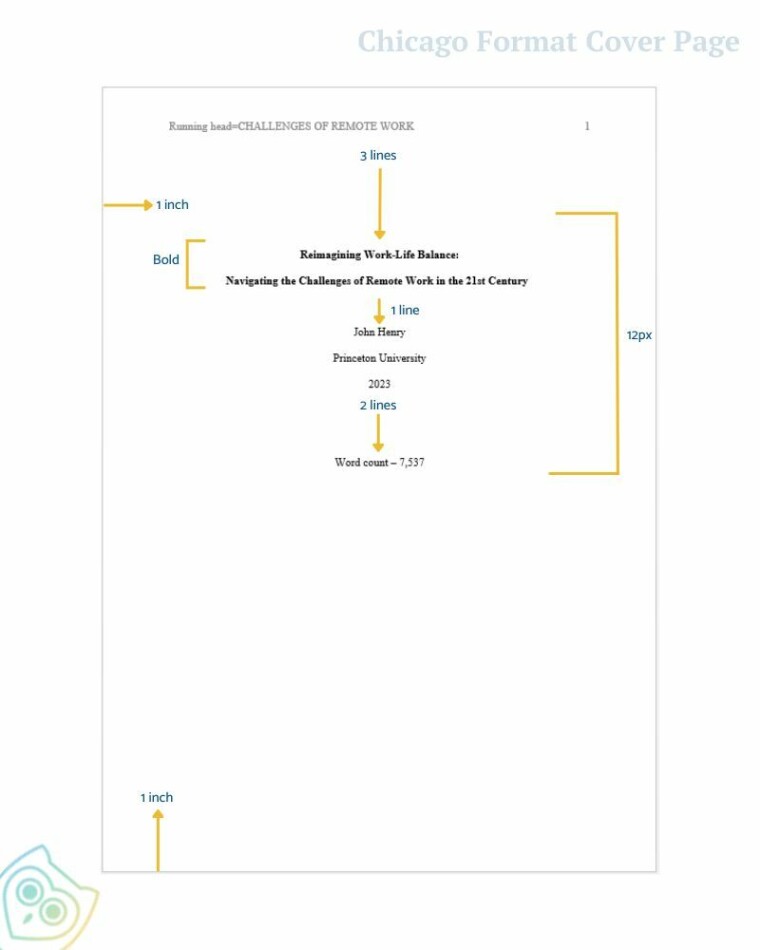
The page may also include a shortened title at the top and a page number in the header of each subsequent page. It’s essential to follow the specific structuring requirements set by your instructor or institution when creating your Chicago-style cover page. The Chicago and Turabian styles are similar in the following ways:
- Both styles typically place the title of the paper one-third to halfway down the cover page, centered horizontally;
- The title is usually in title case; the major words are capitalized;
- The author’s name is listed below the title and centered horizontally;
- The name of the institution with which the author is affiliated is often placed below the author’s name on the page;
- Both styles generally don’t include a page number on the cover page.
Additionally, endeavor to use the same font on your cover page that you use in your paper. Follow proper capitalization rules for essay titles, using uppercase for keywords and lowercase for articles and prepositions unless they begin the title. This ensures consistency and professionalism throughout your research papers; if you have more questions, you can always check PapersOwl’s page for more information.
ASA Style Cover Page
The cover page format of ASA is based on APA and includes a running head. In ASA, keep your header below 60 characters. Another distinction is that ASA mandates the inclusion of a total word count on the cover sheet, encompassing footnotes and references.
Additionally, include your name and course. List them all vertically below your name and course, if you conducted research at several institutions. Apart from these differences, all other elements follow the APA essay format .
It’s worth noting that page numbers start on the title page and must be placed in the bottom-right corner.
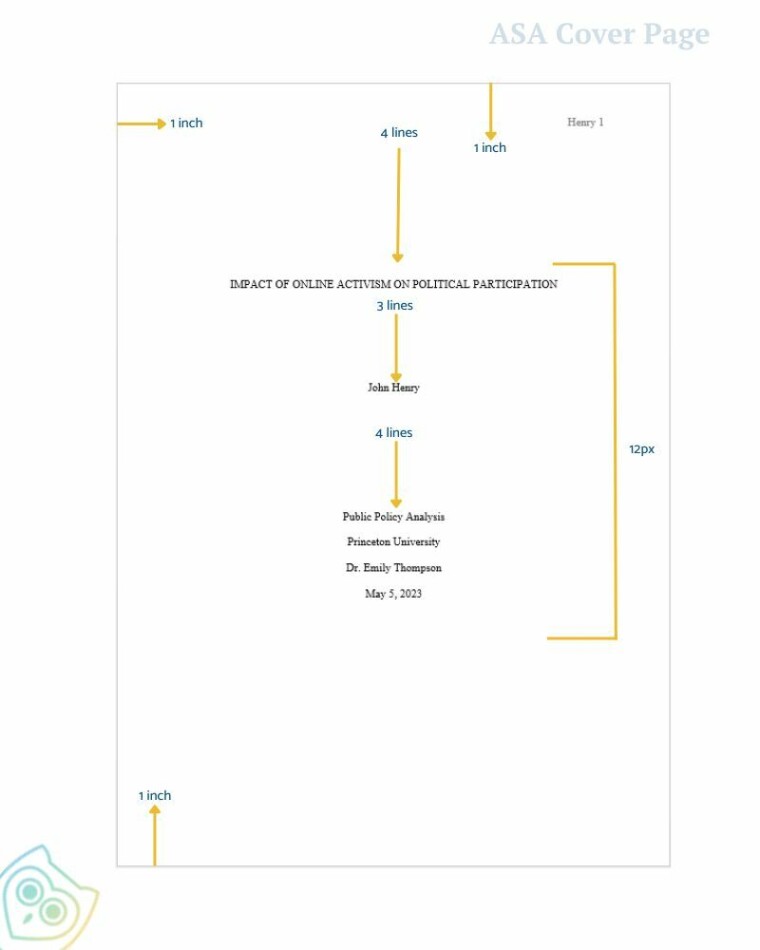
Harvard Cover Page Format
The Harvard cover page is also known as the Harvard referencing style. It is primarily used in social science and humanities disciplines, including literature, history, and economics.
The Harvard cover page example typically includes the following information, arranged in this order:
- Title of the research paper;
- Author’s name (last name, followed by the first initial);
- Date of submission;
- Course name and number;
- Name of instructor.
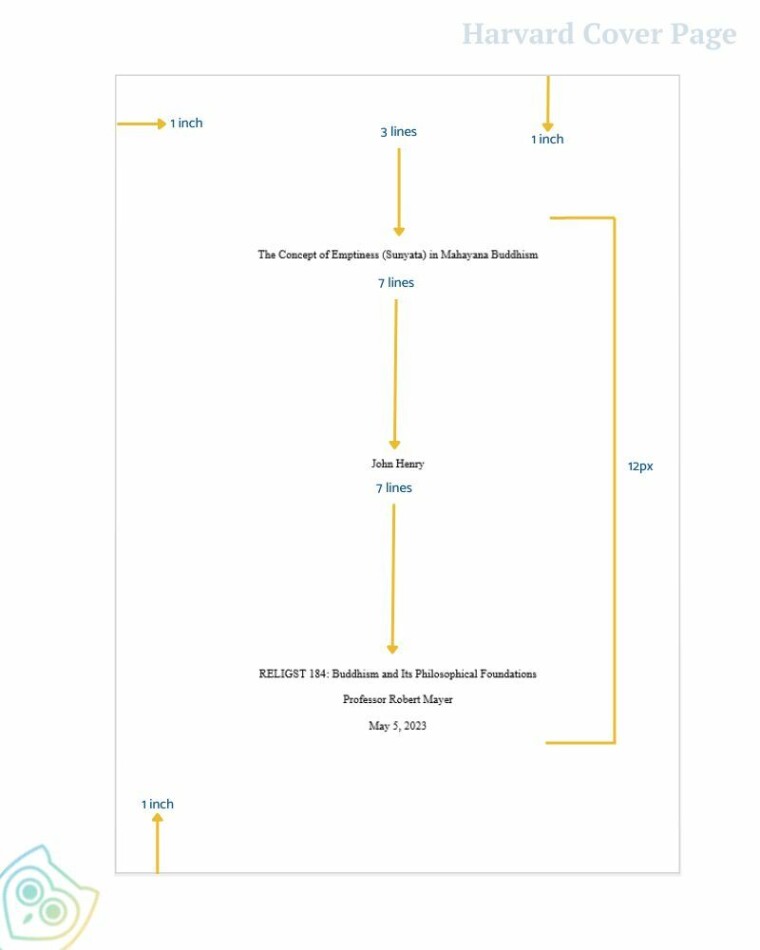
In addition to the cover page, the Harvard referencing format requires in-text citations and a reference list at the end of the document. The in-text citations include the author’s last name and year of publication, while the reference list provides complete bibliographic information for each source cited in the document.
Bottom line
Although formatting your work according to the requirements of your college might be challenging, it is vital. Undergraduate students, who sometimes take classes in several different areas at once, should be especially concerned about this. However, keep these requirements from obstructing your ability to learn. Use these suggestions to create the ideal cover page, and if you need assistance, we are always here to help. And if your professors require some changes, their instructions hold more weight than the guidelines mentioned here.
Readers also enjoyed

WHY WAIT? PLACE AN ORDER RIGHT NOW!
Just fill out the form, press the button, and have no worries!
We use cookies to give you the best experience possible. By continuing we’ll assume you board with our cookie policy.

IMAGES
VIDEO
COMMENTS
The Modern Language Association (MLA) does not require you to create a cover page when you complete your research paper, but some instructors may require it. If your instructor requires your paper to have a cover page, here is how to make it (very easy). This cover page should include: your school name, your research
Step-by-step instructions. Here are the steps you need to take to create the perfect MLA title page: At the top of the page, type the name of your high school, college, or university (if applicable). Skip down approximately one-third of the page and type the title of your research paper using title case.
To create an MLA format title page, list the following on separate lines, left-aligned at the top of the page: Then leave a few blank lines and list the title of the paper, centered and in title case, halfway down the page. All text should be double-spaced and in the same font as the rest of the paper. Note: If you're using a title page ...
A title page is on its own page before the main paper copy, centers the text, and spreads the text throughout the title page. An MLA heading appears on the same page on which the main paper copy starts, the heading is aligned to the left, and it only appears at the top of the page. For more information on how to create headings, refer to the ...
Follow these steps to write a title page in MLA format: Launch Microsoft Word and open a blank document. Under the "File" menu, click on the "New" tab. Use the search bar and type "MLA" to find a sample template. Select the template that corresponds to your document type (research paper, essay, etc.). Check the preformatted document ...
The Modern Language Association (MLA) does not require you to create a cover page when you complete your research paper, but some instructors may require it. If your instructor requires your paper to have a cover page, here is how to make it (very easy). This cover page should include: your school name, your research
MLA cover page requirements. 1 inch margins on all sides. Easily readable typeface (like Times New Roman), 11 or 12 points. Double-spacing throughout the paper. A header in the upper right-hand corner: give your last name, followed by a space with the page number. This should be included on all pages, one-half inch from the top.
An MLA research paper does not need a title page, but your instructor may require one. If no instructions are given, follow the MLA guidelines below: ... For a research paper written collaboratively by several students, such as for a group project, create a title page instead of listing all authors in the header on page 1 of the essay. On the ...
Formatting the First Page. Since you're not required to provide a separate cover page, you'll need to place your name, the teacher's name, the course and the date on the top of the first page. Include the page number on the first page, following these guidelines: 0.5 inches from the top. Right-justified. Your last name and page number.
Cite your MLA source. Start by applying these MLA format guidelines to your document: Use an easily readable font like 12 pt Times New Roman. Set 1 inch page margins. Use double line spacing. Include a ½" indent for new paragraphs. Include a four-line MLA heading on the first page. Center the paper's title.
Do not use a period after your title or after any heading in the paper (e.g., Works Cited). Begin your text on a new, double-spaced line after the title, indenting the first line of the paragraph half an inch from the left margin. Fig. 1. The top of the first page of a research paper.
Cover pages can include the name of your school, your paper title, your name, your course name, your teacher or professor's name, and the due date of the paper. If you are unsure of what to include, check with your instructor. Here is an example of a cover page in MLA format: For more help making cover or title pages, visit our title page ...
Type your paper on a computer and print it out on standard, white 8.5 x 11-inch paper. Double-space the text of your paper and use a legible font (e.g. Times New Roman). Whatever font you choose, MLA recommends that the regular and italics type styles contrast enough that they are each distinct from one another.
MLA Sample Paper. This resource contains a sample MLA paper that adheres to the 2016 updates. To download the MLA sample paper, click this link.
Certain essays may also require a title page. Learning about writing a cover page in MLA format can help ensure you have the proper formatting and relevant information before submitting your essay. In this article, we discuss what the MLA format is, how to create an MLA title page, a template, example and tips.
MLA (Modern Language Association) style is most commonly used to write papers and cite sources within the liberal arts and humanities. This resource, updated to reflect the MLA Handbook (9th ed.), offers examples for the general format of MLA research papers, in-text citations, endnotes/footnotes, and the Works Cited page.
Here is a sample paper in MLA format that has both the cover page and the outline pages. This paper has 10 pages so if you are under a slow Internet connection, please wait a few seconds for all of the pages to load. This paper is current with the latest MLA manual. - Diana Hacker
This is a brief tutorial demonstrating how to format a cover page in Microsoft Word using the 8th edition of MLA Format.
MLA Format Essay Cover Page Example. John Smith. Dr. Hazlett. English 203: Introduction to Shakespeare. October 1, 2023. The Victimization of Ophelia. MLA Format Essay Cover Page Template. Your Name. Instructor Name. Course Number: Course Title. Month Day, Year. Title of Your Paper. APA. In APA style, there are actually multiple formats for ...
Now that you know the basics, it's time to look at the different formatting aspects you need for your cover page, headings, headers, text formatting, and tables. MLA Cover Page. MLA papers don't typically have a cover page. But, if a teacher asks for one, it's essential to know how to do it. An MLA cover page includes a few things like:
Well, just like MLA, an APA essay cover page is easy to make. To begin with, the APA style title page should include: Running head (Left aligned in the header section). Page Number (Right aligned). Title and subtitle of the essay/paper (centered) Name of the author (centered). Institutional Affiliation (centered).
The MLA cover page has a vague format for essay pages. Instead, formatting guidelines are based on your teacher's preferences and standard MLA (Modern Language Association) text formatting. You can follow some best practices to create an MLA essay cover that looks professional. A typical sample MLA cover centers essay titles about one-third ...